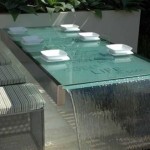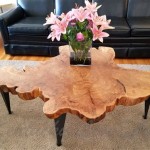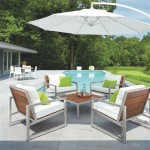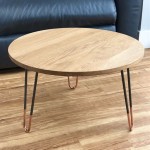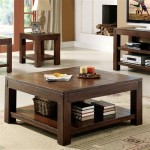Outdoor Coffee Table with Beverage Cooler: Enhancing Your Patio Lifestyle
The outdoor coffee table with a beverage cooler represents a compelling fusion of functionality and leisure, offering a convenient solution for individuals seeking to maximize their outdoor living space. This hybrid furniture piece serves a dual purpose: providing a stable surface for drinks, snacks, and decor while simultaneously keeping beverages chilled and readily accessible. The integration of these features streamlines outdoor entertaining, eliminating the need for frequent trips indoors and enhancing the overall convenience of outdoor gatherings.
The market for outdoor coffee tables with beverage coolers has expanded considerably in recent years, reflecting an increasing demand for products that prioritize both utility and aesthetic appeal. Consumers are actively seeking ways to optimize their patios, decks, and garden areas, transforming these spaces into extensions of their indoor living environments. The incorporation of a beverage cooler within a coffee table design caters directly to this desire, offering a practical and stylish addition to any outdoor setting.
The design considerations for these tables encompass a wide range of factors, including material selection, cooler capacity, insulation properties, and overall dimensions. Manufacturers employ various materials, such as weather-resistant woods, durable plastics, and powder-coated metals, to ensure the longevity and resilience of the table in outdoor conditions. The cooler compartment typically features insulated walls to maintain optimal temperatures for extended periods, and drainage systems are incorporated to facilitate easy cleaning and prevent water accumulation.
Material Considerations for Longevity and Aesthetics
The choice of materials plays a pivotal role in determining the durability, maintenance requirements, and aesthetic appeal of an outdoor coffee table with a beverage cooler. Several options are commonly employed, each offering distinct advantages and disadvantages.
- Wood: Wood, particularly teak, cedar, and redwood, is a popular choice due to its natural beauty and resistance to decay. These woods contain natural oils that repel insects and prevent moisture absorption, making them suitable for outdoor use. However, wooden tables require regular maintenance, including cleaning and sealing, to prevent weathering and fading. The aesthetic versatility of wood allows for a wide range of styles, from rustic and traditional to modern and minimalist.
- Plastic: High-density polyethylene (HDPE) and other durable plastics are increasingly used as alternatives to wood. Plastic tables are resistant to water damage, insects, and fading, requiring minimal maintenance. They are also often more affordable than wooden options. While plastic may not possess the same inherent aesthetic appeal as wood, advancements in manufacturing have resulted in plastic tables that mimic the appearance of natural materials.
- Metal: Powder-coated aluminum and steel are commonly used for the frames and legs of outdoor coffee tables. Metal provides superior strength and stability, ensuring the table can withstand heavy use. Powder coating enhances the metal's resistance to rust and corrosion, extending its lifespan. Metal tables often exhibit a sleek and contemporary design, complementing modern outdoor settings. The incorporation of metal elements, such as stainless steel accents, can also enhance the table's visual appeal.
The interplay between these materials also allows for unique designs. Combining a wooden tabletop with a metal frame creates a blend of natural and industrial aesthetics. Integrating plastic components into the cooler compartment ensures effective insulation and ease of cleaning. Understanding the properties of each material is crucial for selecting a table that meets specific performance and aesthetic requirements.
Cooler Design and Functionality
The beverage cooler component is the defining feature of these tables, influencing their practicality and overall usability. A well-designed cooler should effectively maintain cold temperatures, provide sufficient capacity for storing beverages, and incorporate features that simplify operation and maintenance.
Key design elements of the cooler include:
- Insulation: The effectiveness of the cooler depends heavily on the quality of its insulation. Thick, closed-cell foam insulation is commonly used to minimize heat transfer and maintain cold temperatures for extended periods. Some high-end models may incorporate vacuum insulation technology, which offers even greater thermal performance.
- Capacity: The cooler's capacity is typically measured in terms of the number of standard-sized cans or bottles it can accommodate. Capacity ranges vary widely, allowing consumers to choose a table that suits their specific needs. For small gatherings, a cooler with a capacity of 30-40 cans may suffice, while larger parties may require a capacity of 50 cans or more.
- Drainage: A drainage system is essential for removing melted ice and preventing water accumulation within the cooler compartment. A simple drain plug located at the bottom of the cooler allows for easy drainage. More sophisticated designs may incorporate a hose connection for directing the drainage water away from the table.
- Lid Design: The cooler lid is crucial for maintaining temperature and preventing spills. Hinged lids provide convenient access to beverages, while removable lids offer greater flexibility for cleaning and loading the cooler. Some models feature airtight seals to further enhance insulation and prevent condensation.
The internal layout of the cooler can also influence its functionality. Dividers or organizational trays help to keep beverages separated and prevent them from shifting during transport. Removable bins facilitate easy cleaning and allow for customized configurations. The integration of LED lighting within the cooler compartment enhances visibility, particularly during evening gatherings.
Features and Functionality: Enhancing the User Experience
Beyond the basic functionality of a coffee table and beverage cooler, many models incorporate additional features designed to enhance the user experience and provide added convenience. These features can range from simple additions, such as bottle openers and accessory trays, to more sophisticated integrations, such as Bluetooth speakers and USB charging ports.
Common features include:
- Built-in Bottle Opener: A conveniently located bottle opener eliminates the need to search for a separate opener, streamlining the process of opening bottled beverages. The bottle opener is typically integrated into the frame or side of the table, ensuring easy accessibility.
- Accessory Trays: Removable accessory trays provide a dedicated space for storing snacks, condiments, or other small items. These trays help to keep the table surface organized and prevent clutter.
- Bluetooth Speakers: Some models incorporate Bluetooth speakers, allowing users to stream music directly from their smartphones or other devices. The speakers are typically waterproof and designed to withstand outdoor conditions.
- USB Charging Ports: USB charging ports provide a convenient way to charge mobile devices while relaxing outdoors. These ports are typically powered by a built-in battery or via an external power source.
- Adjustable Height: Certain models feature adjustable height mechanisms, allowing the table to be used as a standard coffee table or raised to a comfortable height for dining or playing games.
- Integrated Lighting: LED lights can be integrated into the table's design to provide ambient lighting for evening gatherings. The lights can be powered by batteries or via an external power source.
The inclusion of these features can significantly enhance the overall enjoyment of the outdoor coffee table with a beverage cooler. Consumers should carefully consider their individual needs and preferences when selecting a table with specific features. The goal is to choose a model that provides the right balance of functionality, convenience, and aesthetic appeal for their outdoor living space.
The selection of an outdoor coffee table with a beverage cooler requires a careful evaluation of several factors, including material quality, cooler capacity, insulation properties, and additional features. By considering these aspects, consumers can find a table that meets their specific needs and enhances their outdoor living experience. As the demand for functional and stylish outdoor furniture continues to grow, the outdoor coffee table with a beverage cooler remains a popular and practical choice for individuals seeking to optimize their patio or deck.

Outdoor Coffee Table With Beverage Cooler Shades Of Blue Interiors

Outdoor Coffee Table With Beverage Cooler Diy Plans

Diy Outdoor Pallet Coffee Table With Drink Cooler Remodelaholic

Diy Outdoor Coffee Table With Drink Cooler Woodworking Plan Remodelaholic

Coffee Table Drink Cooler

Beer Cooler Coffee Tables Pop Up Ottoman

Diy Outdoor Coffee Table How To Make An With Beverage Cooler

Outdoor Coffee Table With Beverage Cooler Shades Of Blue Interiors Decor Cool Tables Summer Porch

13 Diy Cooler Table Plans To Build For Outdoor Beer Drinks Or Patio Picnic Free Furniture

Diy Outdoor Coffee Table With Drink Cooler Free Woodworking Project Plan
